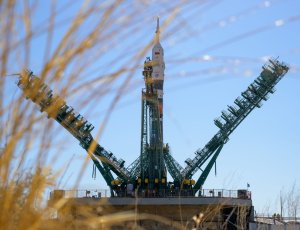Sept. 11 (UPI) — An American astronaut and two Russian cosmonauts successfully launched Wednesday for a six-month mission to the International Space Station and the transition from one mission crew to another.
Roscosmos cosmonauts Alexey Ovchinin and Ivan Vagner departed Earth in a live-streamed event with NASA astronaut Don Pettit on time at 12:23 p.m. EDT aboard the Russian Soyuz spacecraft atop a Soyuz rocket from Baikonur Cosmodrome in east-central Kazakhstan, a large former Soviet satellite nation south of western Russia.
The spacecraft arrived at the ISS and “safely docked” 3:33 p.m. as it was orbiting above Ukraine, according to officials. The hatch between Soyuz and the ISS is expected to open around 5:50 p.m. EDT for the space travelers to finally set foot on the space station.
The flight went flawlessly, according to NASA, and with the arrival of the three marks for the first time in human history a record 19 people are in space at the same time across four different spacecrafts, according to NASA.
“All three stages operated as expected during an eight-minute and 45-second ride to place Soyuz in its preliminary orbit,” NASA’s launch commentator Anna Schneider said at Johnson Space Center in Houston, Texas.
Three hatches have to be pressurized and checked before being opened around 5:50 pm over the two-hour period after the spacecraft arrived at its orbital destination.
The three veteran astronauts join the Expedition 71 space crew on the ISS for the next six months in its transition to Expedition 72.
Leaving on Russia’s Soyuz MS-25 for the return back to Earth will be NASA astronaut Tracy Dyson with Russian cosmonauts Oleg Kononenko and Nikolai Chub.
All three new space station arrivals have previously been to space and this was Pettit’s fourth launch, adding to his accumulated 370 days already in space.
Vagner previously launched in 2020 aboard Soyuz for Expeditions 62 and 63.
One of my star trails from @Space_Station, blurring golden city lights with the arcing stars of deep space.
Composites like this are made from many images, creating a time history of earthly and cosmic phenomena that maps our universe as a function of time. The blue marks of… pic.twitter.com/w1lK39HFuP— Don Pettit (@astro_Pettit) June 1, 2024
Ovchinin likewise had launched on multiple missions, all in onboard Soyuz, such as Expeditions 47 and 48 in 2016 to the ISS. He also did the Soyuz MS-10 spacecraft launch on Oct. 11, 2018, that aborted safely after a rocket problem and Expeditions 59 and 60 in 2019, which was a successful retry following that abort.
Pettit’s first mission on Expedition 6 on Nov. 23, 2002, on the space shuttle Endeavour’s STS-113 mission was to last a little more than two months but was delayed on May 3, 2003, amid the Columbia disaster on Feb. 1., 2003. That incident killed seven astronauts.
His arrival back to Earth on the Soyuz TMA-1 spacecraft was successful but not without complications. A malfunction caused Pettit’s craft to land nearly 300 miles off its expected target. In November 2008, Pettit also flew to space on the shuttle mission STS-126 and was aboard Soyuz TMA-03M with space station Expeditions 30 and 31 from Dec. 21, 2011, to July 1 the next year.
In March, a previous crewed Soyuz mission to the International Space Station from Kazakhstan had been scrubbed over technical issues.
Pettit, a noted NASA photographer who designed the Expedition 72 patch, said during a pre-launch interview last month that “it’s a little different” each time a person goes to space, describing his experiences as a “home away from home.”
“Like a cowboy that wants to be on a horse out in the range, I’m an astronaut that needs to be sitting on a rocket and flying in space,” he told Spaceflight Now.
His photography goals once back in orbit will be to focus on nighttime images and on capturing an “interesting phenomenon” using new lenses. An example he said, is an “atmospheric phenomenon” associated with the aurora called STEVE, or strong thermal emission velocity enhancement.
Pettit said he sought insight from fellow NASA astronauts currently in space on the many changes that have taken place since his last trip to space 10 years ago.
“I was surprised at their answer,” he said. “They said station is cleaner, more organized and the software tools we have for stowage and for doing inventory management and even our operating days through the scheduled timeline, these tools, these software tools are so much more efficient than what we had in the past.”
He said the NASA crew in space now “were impressed” with “the efficiencies of operation” on the ISS compared to how things were 10 years ago or more.
Pettit, who says he has no immediate plans to step away from space travel, added nothing can replace the sensation of traveling back to space.
“There’s just a certain facet of when I go into space that just fundamentally is just fundamentally on resonance with my soul,” he said.

COMMENTS
Please let us know if you're having issues with commenting.